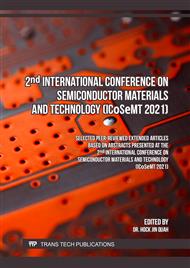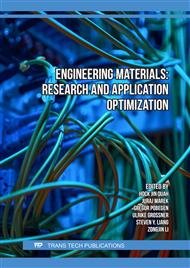[1]
N. Sabri, S.A. Aljunid, M.S. Salim, S. Fouad, Fiber optic sensors: Short review and applications, Springer Ser. Mater. Sci. 204 (2015) 299–311.
DOI: 10.1007/978-981-287-128-2_19
Google Scholar
[2]
W. Zhou, Y. Zhou, J. Albert, A true fiber optic refractometer, Laser Photonics Rev. 11 (2017).
DOI: 10.1002/LPOR.201600157
Google Scholar
[3]
G. Aronne, P. Malara, Fiber-optic refractometer for in vivo sugar concentration measurements of low-nectar-producing flowers, New Phytol. 224 (2019) 987–993. https://doi.org/.
DOI: 10.1111/NPH.16084
Google Scholar
[4]
B.K. Tariyal, A.H. Cherin, Optical Fiber Communications, Encycl. Phys. Sci. Technol. (2003) 271–294.
DOI: 10.1016/B0-12-227410-5/00521-4
Google Scholar
[5]
G. Krishnan, N. Bidin, M. Abdullah, M.F.S. Ahmad, M.A.A. Bakar, M. Yasin, Liquid refractometer based mirrorless fiber optic displacement sensor, Sensors Actuators A Phys. 247 (2016) 227–233.
DOI: 10.1016/J.SNA.2016.05.040
Google Scholar
[6]
H. Ujihara, N. Hayashi, K. Minakawa, M. Tabaru, Y. Mizuno, K. Nakamura, Polymer optical fiber tapering without the use of external heat source and its application to refractive index sensing, Appl. Phys. Express. 8 (2015) 072501.
DOI: 10.7567/APEX.8.072501
Google Scholar
[7]
S.W. Harun, H.Z. Yang, H. Ahmad, Theoretical and experimental studies on liquid refractive index sensor based on bundle fiber, Sens. Rev. 31 (2011) 173–177. https://doi.org/.
DOI: 10.1108/02602281111110031
Google Scholar
[8]
R.M. Andre, C.R. Biazoli, S.O. Silva, M.B. Marques, C.M.B. Cordeiro, O. Frazao, Strain-temperature discrimination using multimode interference in tapered fiber, IEEE Photonics Technol. Lett. 25 (2013) 155–158.
DOI: 10.1109/LPT.2012.2230617
Google Scholar
[9]
F. Jiménez, G. Aldabaldetreku, G. Durana, J. Arrue, J. Mateo, J. Zubia, M. Lomer, Analysis of the use of tapered graded-index polymer optical fibers for refractive-index sensors, Opt. Express, Vol. 16, Issue 21, Pp. 16616-16631. 16 (2008) 16616–16631.
DOI: 10.1364/OE.16.016616
Google Scholar
[10]
D. Monzón-Hernández, D. Luna-Moreno, J. Villatoro, In-line optical fiber sensors based on cladded multimode tapered fibers, Appl. Opt. Vol. 43, Issue 32, Pp. 5933-5938. 43 (2004) 5933–5938.
DOI: 10.1364/AO.43.005933
Google Scholar
[11]
C.A.J. Gouveia, J.M. Baptista, P.A.S. Jorge, Refractometric Optical Fiber Platforms for Label Free Sensing, Curr. Dev. Opt. Fiber Technol. (2013).
DOI: 10.5772/55376
Google Scholar
[12]
K.T. V. Grattan, B.T. Meggitt, Optical fiber sensor technology, (1995) 499.
Google Scholar
[13]
S. Korposh, S.W. James, S.-W. Lee, R.P. Tatam, Tapered Optical Fibre Sensors: Current Trends and Future Perspectives, Sensors 2019, Vol. 19, Page 2294. 19 (2019) 2294.
DOI: 10.3390/S19102294
Google Scholar
[14]
S.H. Girei, A.A. Shabaneh, H. Ngee-Lim, M.N. Hamidon, M.A. Mahdi, M.H. Yaacob, Tapered optical fiber coated with graphene based nanomaterials for measurement of ethanol concentrations in water, Opt. Rev. 2015 223. 22 (2015) 385–392.
DOI: 10.1007/S10043-015-0075-8
Google Scholar
[15]
W. Jin, H.L. Ho, Y.C. Cao, J. Ju, L.F. Qi, Gas detection with micro- and nano-engineered optical fibers, Opt. Fiber Technol. 19 (2013) 741–759. https://doi.org/10.1016/J. YOFTE.2013.08.004.
DOI: 10.1016/j.yofte.2013.08.004
Google Scholar
[16]
A. Greenstein, A. Katzir, A. Messica, Theory of fiber-optic, evanescent-wave spectroscopy andsensors, Appl. Opt. Vol. 35, Issue 13, Pp. 2274-2284. 35 (1996) 2274–2284. https://doi.org/.
DOI: 10.1364/AO.35.002274
Google Scholar
[17]
A. Wang, J.M. Weiss, K. Rahnavardy, V. Arya, Investigation and application of the frustrated-total-internal-reflection phenomenon in optical fibers, Appl. Opt. Vol. 36, Issue 10, Pp. 2183-2187. 36 (1997) 2183–2187.
DOI: 10.1364/AO.36.002183
Google Scholar



